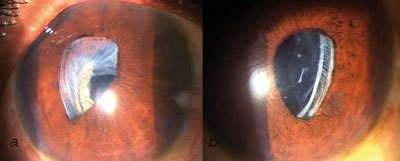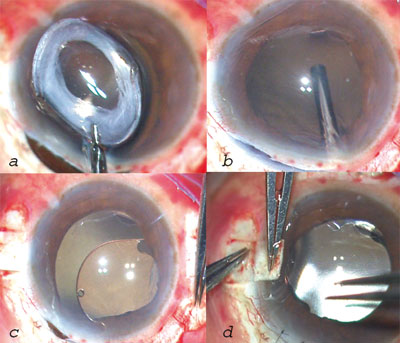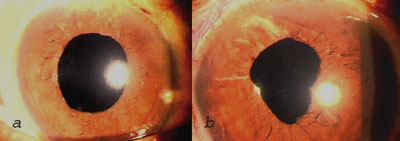In-the-bag IOL subluxation managed with glue-assisted implantation technique
Fibrin glue-assisted sutureless fixation of a posterior chamber IOL is helpful in eyes with deficient capsular support.
 Amar Agarwal |
In-the-bag IOL dislocation is an entity that has been seen increasingly in recent years, after it was first described by Davison.
The popularization of continuous curvilinear capsulorrhexis in cataract surgery with the advent of phacoemulsification has resulted in an increased incidence of capsular contracture and associated in-the-bag IOL subluxation. Spontaneous in-the-bag IOL posterior dislocation is associated with various conditions, among which pseudoexfoliation is most commonly encountered. Other common conditions include uveitis, trauma, vitrectomy, increased axial length and angle-closure glaucoma. It has usually been managed by IOL explantation followed by implantation of either an anterior chamber IOL or an iris- or scleral-fixated IOL.
In this case report, we present a bilateral anterior IOL subluxation managed by fibrin glue-assisted sutureless posterior chamber IOL implantation — a glued IOL — that has not been reported before.
Case report
A 58-year-old man presented to us with a history of gradual diminution of vision in both eyes over 6 months. His previous ocular records revealed that he had undergone bilateral uneventful phacoemulsification surgery with posterior chamber IOL implantation.
On ocular examination, his best corrected visual acuity was 20/80 in the right eye and 20/120 in the left eye. Slit lamp examination showed bilateral anterior subluxated single-piece foldable hydrophobic acrylic IOLs. Both eyes showed anterior capsular fibrosis and contracture, with subluxation of the temporal haptic of the IOL along with the capsular bag into the anterior chamber (Figure 1). Corneas were clear, and anterior chambers were normal. Specular counts were 2,845 cells/mm² in the right eye and 3,275 cells/mm² in the left eye.
|
Images: Agarwal A |
Fundus examination revealed disc pallor, arteriolar attenuation and retinal pigmentary bony spicules corroborative with the diagnosis of retinitis pigmentosa.
Fundus photographs revealed a hazy view due to the subluxated IOL. IOP recorded by non-contact tonometry was 12 mm Hg in the right eye and 13 mm Hg in the left eye. Visual field examination revealed tubular vision in both eyes. Electroretinography patterns were suggestive of retinitis pigmentosa. Previous OCT records revealed altered foveal contour suggestive of healed cystoid macular edema associated with retinitis pigmentosa.
|
|
Under peribulbar anesthesia, two partial thickness limbal-based scleral flaps about 2.5 mm × 3 mm were made about 1.5 mm from the limbus (Figures 2a to 2d). Two straight sclerotomies with a 22-gauge needle were made about 1.5 mm from the limbus under the existing scleral flaps. An infusion cannula or anterior chamber maintainer can be placed. IOL explantation along with capsular bag was done through the corneoscleral tunnel incision. Minimal anterior vitrectomy was performed to release the vitreous traction. A single-piece rigid PMMA 6.5-mm optic IOL was introduced through the limbal wound, and end-gripping 25-gauge micro-rhexis forceps (MicroSurgical Technology) were passed through the sclerotomy to externalize the haptics. Both the IOL haptics were externalized under the scleral flap followed by wound closure with 10-0 nylon. The haptic ends were tucked in the scleral tunnel made with the 26-gauge needle. Scleral flaps and the conjunctiva were closed with the fibrin glue.
|
|
The patient underwent the same procedure in both eyes within 1 week. The postoperative period was uneventful. One month postop follow-up showed well-centered posterior chamber IOLs with BCVA of 20/30 in both eyes (Figures 3a and 3b) with IOPs of 12 mm Hg and bilateral clear corneas.
Discussion
IOL subluxation along with an intact capsular bag occurs as a result of zonular weakness and/or capsular bag contracture. Hayashi and colleagues have described capsular contracture in patients with retinitis pigmentosa leading to significant IOL decentration and tilt. However, the first case of bilateral IOL anterior subluxation in retinitis pigmentosa was reported by Lee et al in 2004.
Traditionally, cases of in-the-bag dislocation of an IOL have been managed by pars plana anterior vitrectomy with IOL explantation, followed by implantation of either an anterior chamber IOL or a new scleral-fixated posterior chamber IOL, or pars plana vitrectomy with repositioning of the original IOL with scleral fixation sutures. We chose to manage our case by fibrin glue-assisted sutureless fixation of a posterior chamber IOL, which is now our standard method of management of eyes with deficient capsular support.
Compared with cases of anterior chamber IOLs, endothelial cell loss is less with this technique. Complications associated with suture scleral-fixated IOLs, such as uveitis-glaucoma-hyphema syndrome and pseudophakodonesis, are less. The technique is simple, requiring a shorter learning curve than conventional suture scleral-fixated IOLs, and does not require a special IOL. The scleral tucking of the externalized haptics provides enhanced IOL stability and centration. Moreover, there are fewer incidences of frequent complications of secondary IOL implantation, such as secondary glaucoma, cystoid macular edema or bullous keratopathy. Suture-related complications, such as suture erosion, suture knot exposure or IOL dislocation after suture disintegration or broken suture, can be prevented.
Conclusion
Capsular contracture can cause in-the bag IOL subluxation in retinitis pigmentosa, but this can be efficiently managed with a new technique of sutureless fibrin glue-assisted posterior chamber IOL implantation.

- Amar Agarwal, MS, FRCS, FRCOphth, is director of Dr. Agarwal’s Eye Hospital and Eye Research Centre. Prof. Agarwal is the author of several books published by SLACK Incorporated, publisher of Ocular Surgery News, including Phaco Nightmares: Conquering Cataract Catastrophes, Bimanual Phaco: Mastering the Phakonit/MICS Technique, Dry Eye: A Practical Guide to Ocular Surface Disorders and Stem Cell Surgery and Presbyopia: A Surgical Textbook. He can be reached at 19 Cathedral Road, Chennai 600 086, India; fax: 91-44-28115871; e-mail: dragarwal@vsnl.com; Web site: www.dragarwal.com.












